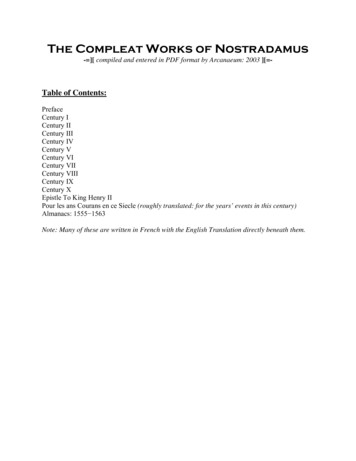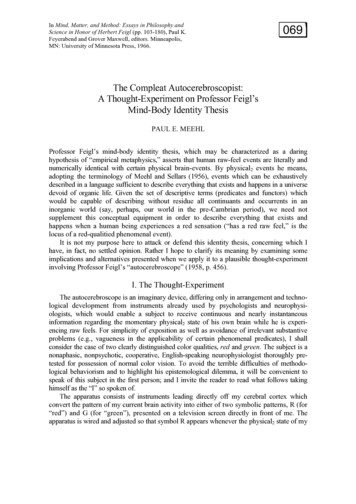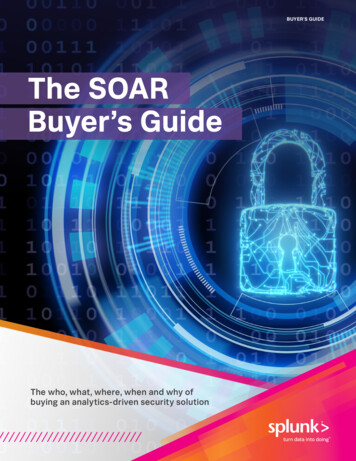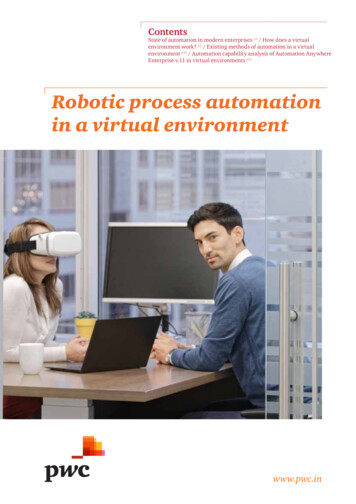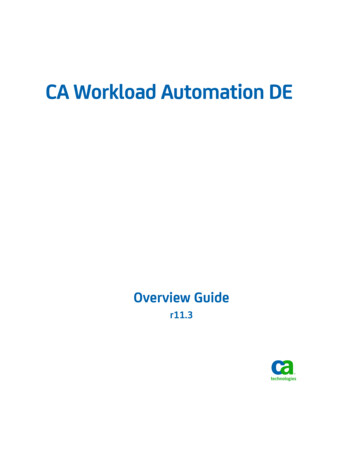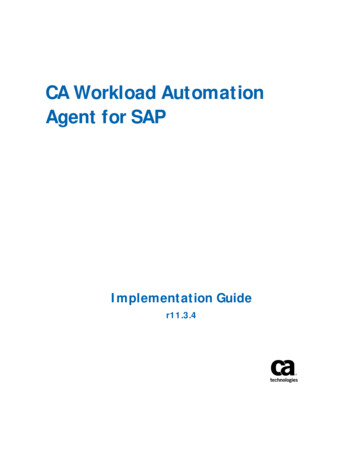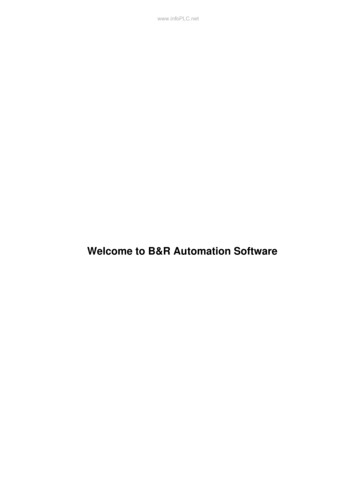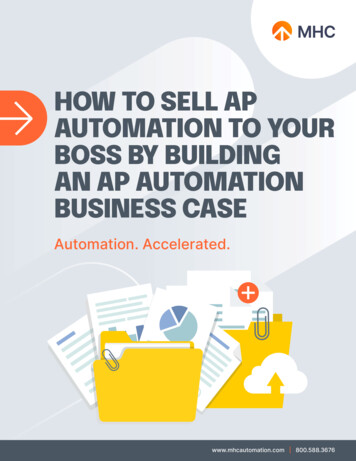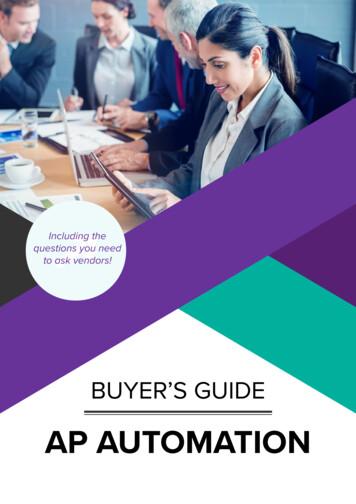
Transcription
WIncluding thequestions you needto ask vendors!BUYER’S GUIDEAP AUTOMATION
The accounts payable functionhas changed.The purpose of this guide is to enable thereader to accurately evaluate the capabilities ofthe wide range of software offerings available,whether you are looking to automate theaccounts payable function for the first time orhave decided to re-evaluate the capabilities andcosts of existing applications.The guide also highlights the hard questionsyou should ask every vendor to clarify what isreally on offer, as it is often what you don’t ask(and the vendor avoids explaining) that leads tofuture disappointment.A summary of all the questions you need to askis provided at the end of this document.1
AP automation componentsThere are six key areas to investigate. Thereader should keep in mind that, as with anyautomation process, the primary objective is toachieve the maximum productivity gains foreveryone involved whilst providing visibility ofthe process to everyone that needs to know; allwhilst keeping the experience very simple andeasy. Capture the purchase invoiceinformation Deployment and the user experiencefor both Finance and the Approvers Determining the general/nominalledger (and other analyses) codinginformation Integration capabilities with yourexisting accounting software The capabilities of the approvalprocess Reporting and information access2
Capture the purchase invoiceAsk the vendor which approachthey use and consider avoidingany application that requires you toundertake the onboarding process;because it is simply a waste of yourtime. Also, check the number of onboarded suppliers in their portfolio.There are three primary methods of capturingthe image and information from a purchaseinvoice. These are detailed below and largelydepend upon how you receive your suppliers’invoices.Simple ScanningScanning the invoice, keying in the invoiceinformation, and linking the image againstthe transaction in the accounting software isthe most basic form of invoice automation.This approach has been around for a longtime and delivers the least value as far bettermethodologies have superseded it. It shouldbe avoided or, if in use, the AP automationapplication should be reviewed and probablyreplaced.OCR (Optical Character Recognition) orDocument ManagementOCR scanning of the paper invoice to capturethe invoice data is the common approach ofmost AP automation applications. Within thisapproach, there are a number of differentelements that need to be explored tounderstand what is really on offer.OnboardingWhat is rarely highlighted is that for the OCRprocess to work, every supplier must first be“onboarded”. The OCR software is effectivelytaught where the relevant information is on thepage for every supplier’s invoice to enable it tolearn to automatically extract the data. It is animportant and time-consuming process to getright. Typically, the supplier onboarding processhas been undertaken by each organisationusing the software, but this approach has beenreplaced by some vendors undertaking thesupplier onboarding process on your behalf.The benefits of a centralised process arethat it aggregates all onboarded suppliers bythe vendor making them available for everyorganisation that utilises that supplier. Thisapproach of leaving this critical task to experts,who spend their day analysing multiple differentinvoice formats in different languages andcurrencies, saves you a great deal of time andalways delivers a higher level of data accuracy.OCR capture accuracyOCR data accuracy is very rarely highlightedor discussed, simply because it cannot deliver100 per cent accuracy. For example, a leadingvendor for Sage claims an 80 per cent OCRaccuracy record, although more sophisticatedapplications can push this into the mid 90 percent.This inherent inaccuracy is the biggestweakness of OCR. However, it can be mitigatedby undertaking automated data validationchecks to ensure that the invoice values arealways correct. A basic validation is to sum upthe line level values to ensure they equal thenet value of the invoice, to have calculated theVAT correctly and compared against the VATtotal, and also to check that net plus VAT equalsthe gross invoice value. Usually, this requiresa high degree of human intervention on everyinvoice scanned for OCR.Ask the vendor to explain their OCRdata capture accuracy and the datavalidation checks taking place, as thiswill highlight the level of confidenceyou will have in the data theapplication extracts.PDF Invoices (including digital documentssuch as Word/Excel/.txt formats etc.)Every business has experienced the rapidgrowth in suppliers emailing their invoices asa PDF document and, for most businesses,emailed PDF invoices are already the primarydelivery mechanism. For some organisations,emailed PDFs already represent over 90 percent of all the inbound invoices.3
Review the number of invoices youreceive as an emailed PDF. Youshould also be aware that the vastmajority of suppliers will willingly sendtheir invoices this way because itsaves them circa 1 for each invoicethey generate, and every invoice isdelivered instantaneously, 100 per centof the time, increasing the likelihood ofprompt payment.also captures the line level information. Somevendors will offer a choice but will usuallycharge more for the line level data extraction.If the vendor’s process does not captureline level information, you will be faced withadditional keying work on every invoice todetermine the appropriate description, codingor costing entries for your general/nominalledgers and project accounting records.Similarly, VAT treatment may be different at linelevel and this needs to be correctly recordedfor your records to accurately present yourbusiness transaction history.The advantages of processing a digitaldocument such as a PDF compared with usingOCR or paper invoices are significant. By asking your suppliers to send invoicesto a specific email address, it is possible toautomatically extract the invoice data forprocessing without intervention on yourpart. The fully automated data extraction processreduces the time taken from the receiptof an invoice to the data being usable to amatter of seconds. Because all the information about theinvoice is already in an electronic formatheld within the PDF, it delivers a far higheraccuracy of data than can be achieved byeven the best OCR technologies.Ask the vendor the options on bothheader level and line level extractionand the costs for each. Avoid solutionsthat do not offer line level dataextraction as it significantly reducesthe level of automation available.Invoice capture summaryTo maximise the productivity gains and speed ofprocessing, getting your suppliers to send theirinvoices via email as a PDF delivers the optimaloutcome. This relegates the less accurate andmore time-consuming OCR methodology to anever-reducing number of paper invoices overtime.The optimal approach to AP automation is toreceive as many invoices as possible directlyvia email as a digital document, as doing soremoves all the laborious scanning effort andthe inherent inaccuracy of OCR.Ask the vendors how they deal withemailed digital documents or PDFinvoices. Your expectation should bethat these are captured and processedwithout touch and with confidence of99.9 per cent accuracy overall and100% accuracy on the invoice values.Header and LineIt is important to determine whether theapplication is simply capturing the invoiceheader data, i.e. supplier, invoice number, ordernumber, date, net, VAT and gross etc., or if it4
Capturing the general ledger codinginformation and approval processHaving digitally captured the invoice with therelevant PDF image attached, the next step is toadd the general ledger coding information, usuallyprior to the invoice being sent for approval, butalso enabling the approver to enter the correctcoding if that is your current methodology.The objective of AP automation is to, wherepossible, fully automate adding the correctgeneral ledger information without userintervention. This may be against a simple generalledger structure, or include departmental analysis,location analysis and even job or project relatedcoding.As important, the relevant general ledger codingmay be allocated against the entire invoice or bedifferent for each line within the invoice.Ask the vendor about the capabilitiesof their general ledger coding structure.Does it handle both header and linelevel coding and check how it willwork if you have multiple locations,departmental analysis or use job orproject costing analysis?and general ledger code and thereafter, thisinformation is automatically appended to thetransaction and delivered directly to the Approverwithout any human intervention.This is a classic example of machine learningat work where the AP automation software hasthe capability to capture the knowledge andexperience of the accounts payable staff andapply the rule on receipt of all invoices that follow.In order to utilise this defaulting capability onthe majority of invoices, the AP automationapplication will need the functional sophisticationto enable the simple capture of the relevant rulesets, both at invoice header level, but also atinvoice line level.A common example of invoice line level defaultingis mobile telephone bills, where each telephonenumber is detailed at line level in the invoice andallocated to a specific department. On processingthe first invoice, a rule is applied to the telephonenumber to default it to the correct department orgeneral ledger code. Thereafter, the processing ofthese invoices is fully automated.Ask the vendor to explain anddemonstrate their capability to capturerules that enable the automated codingof the department or general ledgercodes. This will make the differencebetween continuing to need accountspayable intervention on most invoices,to only touching the minority, theexceptions.The general ledger coding process has alwaysreflected the knowledge and experience of theaccounts payable staff in that they can identify therelevant general ledger code for departmentalanalysis and who was responsible for thepurchase to get the appropriate approval.Detailed analysis of general ledger codingpractices across 20,000 users shows that, formost organisations, between 60 per cent to 80per cent of general ledger coding can be fullyautomated with the correct information beingappended to the invoice without user intervention.A simple example is that a given supplier alwaysrelates to a given department and this is alwaysallocated to a single general ledger code. Onentering the first invoice for this supplier, theaccounts payable staff “default” the departmentException Management describes the way theAP automation application enables the majorityof invoices to be processed without userintervention, leaving just the exceptions. Usingthe telephone bill example, imagine a new mobilephone is purchased and that the automationsoftware does not know how to code it. Theinvoice is now sent to accounts payable for reviewprior to approval, and the task for them is now to5
identify the reason it could not be processed.Exception Management requires the automatichighlighting of the single (or multiple) invoiceline(s) that requires coding, taking the userto that specific line automatically. Oncecoded correctly and defaulted to the relevantdepartment, it will be processed automaticallythereafter.Ask the vendor to demonstrate howthese exceptions are managed tosee whether you will have to tryand identify the problem visually, orwhether it is made extremely easyand fast to address.6
The capabilities of the approvalprocessMany AP automation applications will still requireaccounts payable intervention to decide thecorrect approval process for every invoice,despite the fact the majority will be the sameevery time for a given supplier.The first important capability is to offer the abilityto default the correct approval process, usingsimilar capabilities to automatically append thecorrect general ledger default codes. A significantproportion of suppliers are always related to thesame department or approver, so once this hasdefaulted, the invoice is captured, the generalledger coding added, and this is sent to thecorrect approver with zero touch by accountspayable.Ask the vendor about the ability toautomatically default the correctapproval process and explain thecriteria that can be applied to achievethis. The level of flexibility offered willdetermine how much of this processcan be fully automated.A key objective of automating the approvalprocess is to be able to configure and maintainthe smallest number of approval processespossible. This is achieved by having the flexibilityand intelligence built into each approval processto automate the appropriate number of approvalsteps required.A simple approval process may require just oneapprover, but most organisations will require amultistep process, often based on the value of theinvoice being approved. But this may also changebased on the type of purchase, for example,capital expenditure verses overhead.by the CFO and over 10,000 by the MD.This dynamic approach to approvals is veryimportant, as the alternative is to create an everincreasing number of approval processes forevery possible scenario and then manually selectthe correct one every time, but also maintain themwhen circumstances or staff change.Ask the vendor to demonstrate thecreation of a multi-step workflowand the criteria you can add toautomatically determine, and thenimplement, the correct approval stepsrequired every time.A very useful capability is the creation of“Approval Groups” to deal with either invoices thatcould be approved by multiple people, or whereaccount payable does not know which individualneeds to approve it. The invoice is delivered tothe Approval Group and once approved by oneindividual, moves the invoice to the next step inthe process, maintaining a detailed audit trail ofboth the approver and the time and date it wasapproved.Ask the vendor to demonstrate thecreation and use of an “Approval Group”.The goal of any approval process is to reducethe time from the invoice being received to theapproved invoice being posted to the accountingsoftware ready for timely payment. So, it isimportant that the approver is automaticallynotified of an invoice awaiting approval and canundertake the task at any time from any device.Ask the vendor to explain how theapprover is notified, what functionalityexists to generate automated remindersand then demonstrate the user approvalexperience from any device; especially asmartphone. Detailed analytics show thatThe ideal solution is to create a single workflowprocess which automatically triggers furtherapproval steps when certain criteria are met. Forexample, invoices under 500 can be approvedby management, over 2,000 require a secondapproval from senior management, over 5,0007
smartphone approvals have rapidlybecome the most common form ofapprovals and they also deliver thefastest turnaround.Ask the vendor to demonstrate theapproval process from a mobile device,preferably from a free app downloadedfrom the relevant app stores.Another key aspect of approvals is dealing withthe queries, where the invoice approval hasbeen denied. As the query can be dealt withby the approver or passed back to Financeto arrange a credit note, it is important thateveryone knows the status of the invoice andwho is dealing with it, to manage supplier creditcontrol calls.Whilst most of us are comfortable usingtechnology, there remains a (reducing) numberof people that will want to see a physical copyof the invoice, with the audit trail of approvalsprior to the invoice being paid. This requirementhas often been a primary blocker to invoiceautomation as this requirement often comesfrom the top management of the business.The goal becomes the ability to generateApproval Batches. This is the grouping ofapproved invoices that require final sign off,either prior to posting them to the accountingsoftware, or to enable payment to thesupplier. The batch can either be approved onscreen or printed as a hard copy invoice withaccompanying approval audit report attached.Ask the vendor to show how invoicequeries are managed, the ability toflag the invoice being under query, andwhat notes can be captured againstit to deal with supplier credit control.Also check whether the software willdeliver automated reminders to makesure queries are fully managed to aresolution.There should be a high degree of flexibility inthe generation of these reports; for example,by supplier, by department, by value, bygeneral ledger code or project, as this deliversthe information in a logical order and is verypopular with the same senior management thatwants to retain a physical aspect of the process.An “out of office” functionality is another keyrequirement, where the approver is on holidayor perhaps off sick for several days. Thegoal is to enable the user (or the applicationadmin staff) to set a “nominee” that becomesresponsible for these approvals whilst theindividual is away. The user updates theapplication to say they are away from the officeand their approvals are immediately presentedto their nominated user. On approval, thesystem retains an audit trail of who approvedthe invoice, including the date and time stamp.Ask the vendor if they can provide ahard copy of Approval Batches, asit may make the difference betweengetting sign off for the project or not!Ask the vendor to demonstrate the“out of office” capabilities for boththe user to instigate or for admin toinstigate in their absence.One of the biggest benefits of invoice approvalsis to enable the approver to undertake this taskwhilst they are away from the office. This canbe done from any computer with access to theinternet, or more conveniently, directly fromtheir mobile device.8
Deployment and the user experiencefor both Finance and the ApproversThe biggest barriers to change are usually thecost of the application and the resources requiredto deploy and train your staff to use the newsolution.From a cost perspective, most invoice captureand approval processes are based on the numberof companies it will automate, the number ofusers that need access to the application and thenumber of invoices that are being processed.To ensure that you are getting anaccurate quote, carefully consider whowill need access (it is often more thanyou might think) and review the numberof invoices you receive. This is a goodtime to check how many of thoseinvoices already arrive via email as aPDF because you are probably printingthem out!Modern AP automation applications have beendesigned to be “plug and play”, meaning thatyou should be able to fully deploy the applicationwithout external support. Your ability to do this,and maintain the application through changesinto the future, will be determined by the ease ofuse and the quality of the support both within theapplication and through online support resources.Ask the vendor to demonstrate theirsupport capabilities and clarify theavailability of direct support servicesfrom a member of their staff.The advantage of “plug and play” is that an APautomation application should be fully deployablein a very short timeframe. Perhaps 30 minutes fora simple deployment, but less than half a day fora complex set up. This speed of deployment iscritical to being able to get the solution live withthe minimum amount of disruption and achievingthe huge time savings immediately.Equally as important, the application should bevery simple to use for the Administrators (thepeople in your organisation responsible for set upand maintaining the application), the Operators(usually the accounts payable staff) and perhapsmost important, the Approvers’ experience,because when they use it diligently, it can take aslittle as a few minutes from invoice receipt, to afully approved invoice sitting in your accountingsoftware ready for payment.Ask the vendor to demonstrate the threekey activities of set up and ongoingadministration, the Finance experience,and the end user experience. Everyoneclaims ease of use, but ultimately youneed to be the judge of whether it’s trueor not.To be able to make the change, it is important thatsenior management is unanimously convinced ofthe benefits to the business. It is too easy to justfocus on what AP automation will do for Finance,so be sure to both understand and communicatethe benefits that are delivered to the seniormanagement and the approvers, or the project isunlikely to happen.The most significant change for the Approvers isthe wealth of real-time information that becomesavailable on their suppliers. Rather than dependon monthly management reports and continuouscalls to Finance, the exact status of every invoicecan be securely accessed by everyone that needsto know.This includes supplier turnover, the status of everyinvoice whether awaiting approval, under query,approved and even whether it has been paid. Askey supplier relationships are often critical to theapprover’s department and therefore critical tothe business, this information can be invaluable.9
Every approver will welcome the real-timeavailability of this information, as it will helpthem build strong relationships with their keysuppliers (especially if they are paid promptly),whilst also getting best value pricing, suitablecredit limits and the best payment terms.Ask the vendor to highlight thesupplier information available to theapprovers and senior management,and make sure that this ishighlighted to them, as it usuallyensures they fully support for theplan to change.10
Integration capabilities with yourexisting accounting softwareAsk the vendor to explain theirintegration methodology and whetherthere is any work that is requiredby you to keep both the supplier orgeneral ledger (etc.) up to date, or tocapture and then import data into youraccounting system.Whilst integration with online applications likeQuickBooks, Xero and similar software is verystraightforward, the same is not true for olderaccounting applications that are deployed on yourown servers.Integrations with applications like Sage 50, Sage200, Pegasus Opera, Exchequer and otherscan be achieved, but the method of integrationdetermines the amount of work, and possibleissues, that will arise in day to day use.In the ideal world, the integration is in real-time,where all of the supplier and general ledger staticinformation (supplier account codes, paymentterms, currency codes, general ledger accountcodes, department account codes, job costingaccount codes) is accessed in real-time by thenew application. This is the only way to ensurethat every invoice is always using valid accountingdata and ensure that the finally approved invoiceis always successfully posted to the accountingsoftware.Other integration methodologies include theregular manual capture and import of the supplierand general ledger information and the manualexport of approved invoice, followed by a manualimport into your accounting software. Whilst thisapproach can be successful, it requires both timeand diligence to ensure that it takes place as anymistakes will be reflected in the accuracy of youraccounting information.11
Reporting and information accessAP automation delivers the catalyst to rethinkthe way information is shared between Financeand the rest of the business about theirsuppliers.Finance requires the comfort in knowing thatonce an invoice has been sent for processingthat it can never be lost by the automationsoftware vendor prior to the invoice databeing received back, ready for the approvalprocesses. This is particularly important as itmay take the vendor up to four days to processa new supplier for the first time.In most cases, Finance does not want to shareall this information with the rest of the business,so it is important that the application can beconfigured to only provide the information thatis relevant to each individual.Ask the vendor to show how easy andfast it is to control who can see what,ensuring that approvers have accessto only the information that relates tothem.It is equally important that everyone is able tofind the specific information they are lookingfor, so delivering a search capability that isboth very powerful but also easy to use is veryimportant.Ask the vendor what informationis provided within their applicationto verify that an invoice has beenreceived by them and is currentlybeing processed.Ask the vendor to demonstrate theirsearch capabilities within the reportingsection, using multiple searches to drilldown to the relevant information. Also,check whether this information canthen be easily exported (e.g. PDF/Excel)to update other associated activities.There are two types of reports that are requiredto get the most out of AP automation. Activity reports that provide visibility of theinvoices and your ability to manage theprocess through the invoice capture, theapproval process, query management andsupplier management for the credit controlconversations with your suppliers andinternal management, including approvedinvoices awaiting paymentFinancial reports that provide the financialinformation that should include a realtime view of accruals based on everyunapproved invoice, the volume and valueof the unapproved invoices and a detailedweekly or monthly cash requirements reportto simplify maintenance of your corporatecash flow analysis.Ask the vendor to show whatinformation is being maintainedin real-time within their reportingcapabilities, as this determines howvaluable their software will be to thebusiness as a whole.One of the core objectives of AP automationis to enable the approvers to gain access to allthe relevant information about their suppliers,without needing to constantly interrupt Finance.It is worth remembering that most of thebusiness’s key suppliers are usually set up bythe approvers and often they can be crucial tothe performance of your business.Keeping these suppliers on-side will determinethe prices that you pay them, your credit limits,and your relationship with them. As we all know,every business has its good customers and notso good customers and the tendency is to takebetter care of your best customers.AP automation provides the opportunity toenable your senior management access to thereal-time and relevant information about theirsuppliers, every invoice in the approval process,every invoice under query and even every12
Speak to your senior management andask them whether real-time informationabout the financial status of theirsuppliers and the ability to see everyinvoice ever processed on-demandwould be beneficial to them; especiallyif it included an extremely easy and fastapproval process.approved invoice that has not yet been paid; andthey will support the automation project to get it!This is the information that they need to get bestvalue from those suppliers, which is currentlyhidden away in the accounting software and filingcabinets.Ask the vendor how they enable andmanage access to the relevant supplierinformation for the approvers.AP automation should offer so much more tosenior management within the business than amechanism to simply improve the capture andprocessing of invoices, predominately for thebenefit of Finance.For most businesses, the people that work withthe suppliers and approve their invoices forpayment are the senior managers and directorsof the company, so it is only appropriate that theyalso benefit from the AP automation project.From our experience, once the seniormanagement know what is available to them, theybecome the strongest advocates for automationand ensure the project gets the support it needsto start!13
BUYER’S GUIDE: AP AUTOMATIONCHECKLISTCapture the purchase invoiceCapturing the general ledger codinginformation and approval processAsk the vendor which approach they useand consider avoiding any applicationthat requires you to undertake theonboarding process; because it is simplya waste of your time. Also, check thenumber of on-boarded suppliers in theirportfolio.Ask the vendor about the capabilitiesof their general ledger coding structure.Does it handle both header and line levelcoding and check how it will work if youhave multiple locations, departmentalanalysis or use job or project costinganalysis?Ask the vendor to explain their OCR datacapture accuracy and the data validationchecks taking place, as this will highlightthe level of confidence you will have inthe data the application extracts.Ask the vendor to explain anddemonstrate their capability to capturerules that enable the automated codingof the department or general ledgercodes. This will make the differencebetween continuing to need accountspayable intervention on most invoices,to only touching the minority, theexceptions.Review the number of invoices youreceive as an emailed PDF. You shouldalso be aware that the vast majority ofsuppliers will willingly send their invoicesthis way because it saves them circa 1for each invoice they generate, and everyinvoice is delivered instantaneously,100 per cent of the time, increasing thelikelihood of prompt payment.Ask the vendor to demonstrate howthese exceptions are managed to seewhether you will have to try and identifythe problem visually, or whether it ismade extremely easy and fast to address.Ask the vendors how they deal withemailed digital documents or PDFinvoices. Your expectation should bethat these are captured and processedwithout touch and with confidence of99.9 per cent accuracy overall and 100%accuracy on the invoice values.The capabilities of the approvalprocessAsk the vendor about the ability toautomatically default the correct approvalprocess and explain the criteria thatcan be applied to achieve this. Thelevel of flexibility offered will determinehow much of this process can be fullyautomated.Ask the vendor the options on bothheader level and line level extr
accounts payable staff "default" the department and general ledger code and thereafter, this information is automatically appended to the transaction and delivered directly to the Approver without any human intervention. This is a classic example of machine learning at work where the AP automation software has
